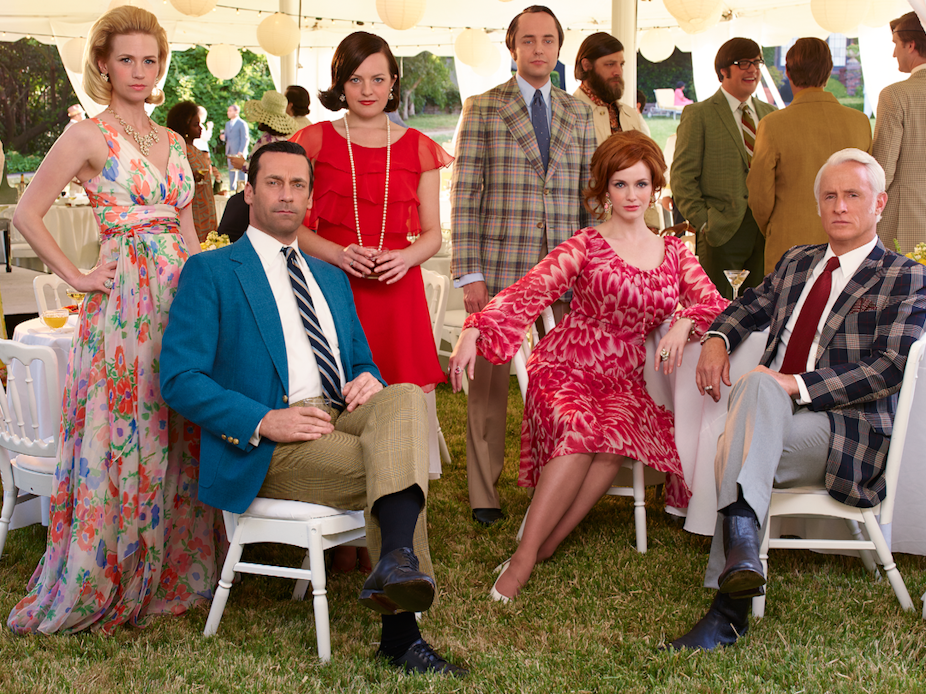The final half of the final season of Mad Men is upon us, and I’m certainly finding it difficult to contemplate life without the Don Draper, his Sterling Cooper colleagues and their families and friends. So as it winds to a close, I’ve been pondering the likely legacy of the show – and thinking about possible alternatives that might be able to fill the hole it will leave.
Much of the appeal of Mad Men stems from its exquisite recreation of a highly stylised and polished vision of the recent past – the impeccable look and style of 1960s and early 1970s fashion and interior design. In this regard, the series shares much with the similarly exquisite cinematic explorations of the late 1950s and 1960s, prominent among them A Single Man and Far From Heaven.
But of course like these films, Mad Men is far more than a showcase for retro-fashion and design. Its telling of the emotional dramas of working life and private life in mid-to-late 20th-century America opened up with great care and subtlety a distinctive landscape of feeling and sentiment. This was a world on the cusp of a sexual revolution and second wave feminism, civil rights and gay liberation. In this world, consumer culture and post-war affluence were shaping a more hedonistic, pleasure-orientated mass culture.

It is Mad Men’s commercial core that most interests me. The show is very good indeed on the seductive power of US advertising, the compelling commercial fables of the good life expressed through the world of consumer goods, “fables of abundance” as the cultural critic Jackson Lears once put it.
And we can learn a lot about this history of the US advertising industry. The show draws out some of the competing tendencies within US advertising of this period. It alludes, for example, to the divisions between the big, boring multinational agencies such as McCann-Erickson and J. Walter Thompson, and the innovative “hot shops” associated with the “new creativity” such as Doyle Dane Bernbach (DDB) and PKL.
Draper’s agency in its various incarnations sits between these two dominant traditions of mid-century US advertising. From DDB, it takes the elevation of the “creativity” of copywriters like Don Draper as an agency’s key asset. But unlike DDB, Don Draper’s advertising copy is generally “folksy” in the tradition of the big agencies including Leo Burnett, lacking the urbane New York Jewish wit that became DDB’s trademark.
But there is a striking absence in Mad Men’s depiction of US advertising and this is its relationship to the wider world. “Overseas” or international advertising rarely figures in the series, which is strange given the international reach of US advertising by the mid-20th century.

American invasion
The only international hint we get is in the third season, which explored the relationship with British advertising when Sterling Cooper was taken over by the London-based Puttnam, Powell and Lowe. But even this story arc revealed little about the world of international advertising, depicting a very idiosyncratic picture of Anglo-American advertising relations.
There were British-owned agencies operating in New York, most notably Ogilvy Benson Mather (later Ogilvy & Mather). But the commercial traffic was overwhelmingly the other way. US agencies dominated British advertising by the late 1960s, and between 1959 and 1967, US agencies bought 32 British firms.
This post-war “American Invasion” built on the presence of US agencies in London since the early 20th century. American advertising staff, US market research, ways of working and approaches to advertising all moved eastwards across the Atlantic. Contemporary critics feared the “Americanisation” of British advertising, but what emerged in these years was a careful selecting, adapting and reworking of US influences. Distinctively British styles of advertising were also born out of an engagement with and resistance to US techniques.
Television advertising represented a classic example of these strategies. While British practitioners were profoundly influenced by techniques pioneered in the US, what appeared on British television were peculiarly British forms of commercial persuasion. As one American commentator on early British TV advertising put it, these “commercials” were about as American as “tea and scones”.
This story of the wider international reach of US advertising and its complex influence upon other national advertising industries perhaps unsurprisingly does not register in Mad Men’s avowedly US-centred view of American advertising. So now that we’re seeing the show off, perhaps its time for a new advertising show, this time a British – or indeed Australian or Indian – version?

